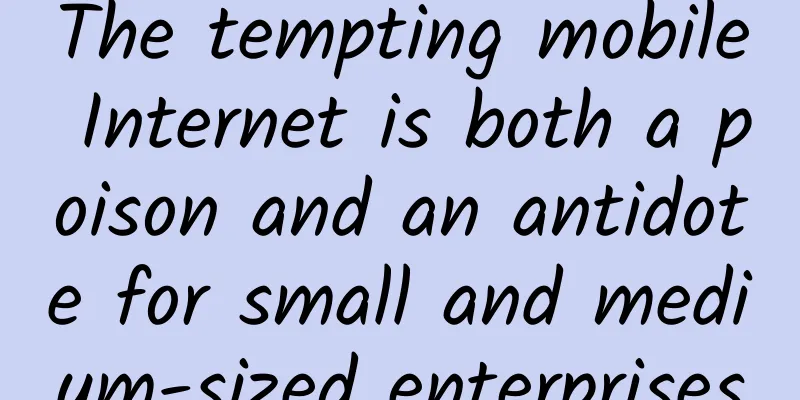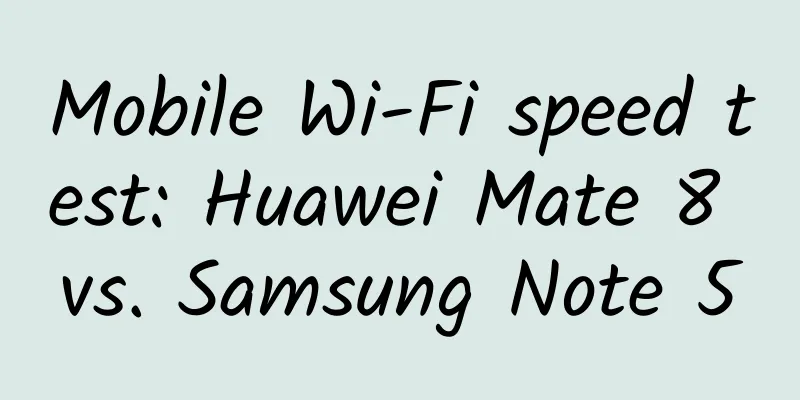The tempting mobile Internet is both a poison and an antidote for small and medium-sized enterprises

|
In just four or five years, the number of mobile Internet users has surpassed that of PC users. What should small and medium-sized enterprises do in the face of such a huge number of users? In other words, what should they do in the face of the wave of mobile Internet? This is a question worth thinking about.
Unlike the rapidly developing mobile Internet, small and medium-sized enterprises are far from sensitive to the attack of mobile Internet. After all, unlike the struggling Internet companies, they have very direct cash flow and a lot of profits in their accounts. The slogans of Internet companies are very loud: subvert today, surpass tomorrow, become the first in the industry the day after tomorrow, lead the market and so on. However, many of the companies listed on IPO are suffering losses. The slower the crisis comes, the slower the change will be. Mobile Internet has led a new wave of development, including both giants from the original PC side such as BAT, as well as new small giants such as Didi Taxi and WiFi Master Key. The first to enjoy the dividends of this trend are either innovators or the original Internet companies that are afraid of losing their market share and therefore transform in time to face the new trend. Caught up in this wave of development (author’s WeChat public account: Guo Jing’s Internet Circle) are the original PC-based small and medium-sized enterprises. Internet giants such as BAT can certainly spend big to transform to mobile Internet, after all, it’s just about throwing money around, and they also have relevant talent teams to match them. However, millions of small and medium-sized enterprises not only do not have a talent team to back them up, but are also reluctant to spend huge sums of money to build a way for survival in the mobile Internet, so it’s natural for them to fall behind. In just four or five years, the number of mobile Internet users has surpassed that of PC users. What should small and medium-sized enterprises do in the face of such a huge number of users? In other words, what should they do in the face of the wave of mobile Internet? This is a question worth thinking about. Baidu's Q3 2015 financial report shows that Baidu had about 623,000 active online marketing customers in the third quarter, including many small and medium-sized enterprises. Sogou's revenue in Q3 2015 reached 1.021 billion yuan, and mobile search revenue accounted for 30% of the total search revenue. For small and medium-sized enterprises that originally relied on PCs to survive, relying on the search engine functions of Baidu, Sogou, and 360 Search is almost the best way to survive. Whether it is SEO or SEM, at least they have figured out the direction, but what about the mobile end? Where should these small and medium-sized enterprises go? Facing the temptation of mobile Internet, is it a poison or an antidote? Traffic is dispersed, and there is no way to go to the dark PC search engines are the largest entry point. Users can find all their needs through search engines. Small and medium-sized businesses only need to have content to attract business. However, mobile traffic is scattered. For example, in men's and gynecological hospitals, users used to use search engines to meet their needs. But now, it may be health applications, search engines, WeChat public accounts, or other niche apps. The traffic from search engines has been greatly dispersed. Some people may say that people who are looking for logistics companies will also use search engines, and there will be a phone number behind the search engine, so they can find the needs with one click. However, users may find this need through a third-party APP. This part of the diversion may be 30%, may be more, or may be lower, and the value of this 30% is not low. This can be divided into some specific areas. In some areas, the to B model has a strong dependence on search engines, while the traffic of some small and medium-sized enterprises that tend to be to C is more dispersed. Traffic is too dispersed, which will consume more energy of small and medium-sized enterprises. In the past, it may have been just SEO and SEM, but now they need to master more traffic skills. Each APP exists independently, and they have to think about how to obtain traffic from each independent APP, because there is no unified entrance, and there is no model that relies on one model all the time. The changes are too fast. Faced with the extremely tempting mobile Internet, the dispersion of traffic is like poison and difficult to digest (if you still see some fake lecturers in the market talking to you about SEO and SEM, you can just coax him off the stage). Content needs a new hosting point The content carrier of small and medium-sized enterprises on the PC side is the website. The website can show more information for the enterprise because all the content is wrapped in the search engine. In terms of visuals, users can browse more information at a glance. What is the carrier of small and medium-sized enterprises on the mobile Internet? The website on the PC side is definitely not good. The corporate website is ugly to begin with. If it is not adapted to the mobile side, it will be even uglier, and the user experience will be very poor. Fortunately, the business promotion departments of search engines are quite enthusiastic. They will enthusiastically call small and medium-sized business owners and ask them to do mobile network promotion advertising. It is difficult for small and medium-sized business owners who originally worked on the PC side to escape this temptation. Most of them still have a helpless experience after being harassed tirelessly. According to my observation, many companies' mobile sites are directly converted from the PC. Their pages don't even have a UI. Most of them use the simplest template. After all, it costs a lot for them to build a mobile site, and it's too difficult to make money from them. They wish that a 3,000 yuan website could be used for decades and that traffic could come automatically. However, mobile screens are smaller than computer screens, which means that users can visually receive less content. If the mobile website UI style is poor, it will be even more difficult to please users. The most important point is that small and medium-sized enterprises are unwilling to create content. They are not willing to contribute content to the Internet. The PC side is willing to do it to enrich the website content and SEO. They themselves are unwilling to spend a lot of manpower and financial resources to do this. Where does the content for the mobile side come from? Do they do it again? They are obviously unwilling to do so. The simplest and crudest way is to switch to a mobile site and use it directly. However, these contents obviously do not meet the needs of mobile users. Users have higher and more fragmented requirements for quality, which requires small and medium-sized enterprises to spend more energy on content. From the perspective of content carrying, mobile websites, APPs, HTML5, and WeChat public accounts are not easy for small and medium-sized enterprises. They are more concerned with ways to make money quickly rather than cumbersome content conversion methods. From mobile search, browsers, and WeChat, no matter which entrance, small and medium-sized enterprises should consider how to give themselves the opportunity to show themselves on the mobile terminal. The mobile terminal pays more attention to the economy. Even if there is user demand, there are more APPs diverting traffic from it. Small and medium-sized enterprises should consider how to show themselves on many independent APPs to gain attention. In terms of content, it is also a poison to small and medium-sized enterprises. Does mobile Internet have no benefits for small and medium-sized enterprises? Not necessarily. Closer to users, easier innovation Search engines are too overbearing for small and medium-sized enterprises. For example, small and medium-sized enterprises that are not paying enterprises are easily affected by the search engine's ranking algorithm. The search engine will indirectly K out these corporate websites, and SEO has more uncertainties. The search engine's algorithm is always changing. For example, Baidu suddenly canceled the Baidu snapshot time. The mobile Internet has added LBS elements, and even in mobile searches, localized search results make users more accurate. Users in Beijing will no longer see the results for Suzhou's needs. Moreover, each independent APP can also position users more accurately, which is more conducive to the development of small and medium-sized enterprises. Compared with the fixed model on the PC side, small and medium-sized enterprises have more variable opportunities on the mobile side. They have more opportunities to try platforms such as Guangdiantong, Cheetah Mobile Advertising Platform, and Toutiao. Moreover, the cost is lower and more convenient. Small and medium-sized enterprises have more opportunities to try on the mobile side. Another point is that many small and medium-sized enterprises do not have websites. In 2014, the online proportion of Chinese hotels was only 10%. On the mobile side, small and medium-sized enterprises have more opportunities to try. Mobile websites, WeChat public accounts, etc. are all very worthwhile to try, including third-party APP marketing, etc., many of which are zero-cost. Compared with the economic winter, there will be more opportunities to try innovation in new areas. The revenue of many Internet companies is inseparable from the contributions of small and medium-sized enterprises, but who cares about their survival? Internet companies want to make money, which is directly transferred to small and medium-sized enterprises. In other words, the cost of small and medium-sized enterprises on the Internet has increased, and there are more "vampires" in the mobile Internet. Small and medium-sized enterprises that are cautious and willing to see results quickly are obviously wavering in this new battlefield. Not everyone wants change. The older you get, the more you like stability. |
<<: The master cracked the Trojan APP and burst into laughter at the end
>>: iOS 9.1 has two major glitches that affect basic iPhone functions
Recommend
[Must-Read for Internet People] After a few years in the industry, where should your future be?
Anyone who has been in this industry for three to...
Take it before or after meals? Here is a list of common medication times! Don’t be careless, save it now!
We often see instructions such as "take befo...
With rising costs and increasing sales, when will the air-conditioning industry be able to break out of the vicious circle of buying high and not buying low?
Since the rise in prices of raw materials such as...
Uber is having trouble retaining talent, with new head of its AI lab Gary Marcus leaving
According to foreign media reports, Gary Marcus, ...
Moments Advertising①: Analysis of Lianjia’s advertising!
On August 15, Lianjia placed an advertisement on ...
The three key points of enterprise private domain traffic operation are "attract", "retain" and "collect".
As public domain traffic becomes increasingly exp...
Flying cars test the waters in the tourism industry, Geely Travel plans to expand into Hainan
On June 3, Geely Group (New Business) Co., Ltd., ...
China Automobile Dealers Association: Automobile consumption increased by 12% in October 2020, and new energy vehicle production increased by 94% to 160,000
According to the data from the National Bureau of...
2500 words user retention analysis
Faced with the current situation of difficulty in...
I frequently get acne around my nose, and some people even say I have kidney deficiency?
Anyone who has had acne knows that there are many...
Shen Gong...Gong...What animals are the true forms of the leopard family?
With the popularity of "Nezha: The Devil Boy...
What to sell at the rural market? An attractive small business that earns 20,000 yuan in 10 months
In fact, there are many small businesses in rural...
Understand the changes in advertising and marketing over the past century in one article!
On the day JWT was merged with digital marketing ...
The latest news on the Changsha epidemic in 2022: What are the specific closed areas today? Attached is the list of gated communities!
Today, the Changsha epidemic suddenly became a ho...
The secret behind Beijing's "snowfall" in April is...
Auditing expert: Yang Yanhui, Senior Garden Engin...









